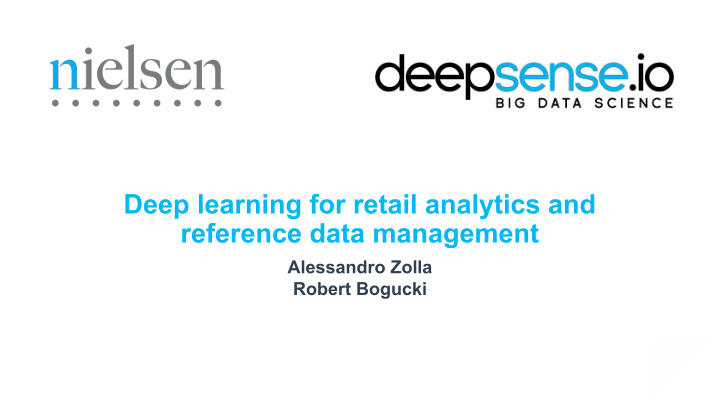



Deep learning for retail analytics and reference data management Alessandro Zolla Robert Bogucki
Nielsen Scope Nielsen measures what people... WATCH BUY ● TV Ratings ● Brick & Mortar ● Advertising exposure ● eCommerce ● TV and Digital media ● FMCG 100+ countries 10M+ active products 40,000+ employees
Nielsen Reference Data Nielsen Reference Data: industry standard for analytics What is Reference Data? It’s the glue that brings Nielsen’s assets together, enabling internal and external data exchange. Our Strategy: 1. Create Foundational Content , leveraging internal resources and partners 2. Build normalized layer of Analytic Ready content 3. Deploy automation to deliver faster and with quality 4. Enable content ecosystem and data exchange
Nielsen RD Layered Content • Market Behavior Dynamic Characteristics based on market place data • e.g. On-Line only, Purchasing Demographic based Dynamic Chars • Client Characteristics are fully created, coded and maintained by Client Maintained Characteristics • Characteristics are managed and maintained by Nielsen Innovation • Dynamically maintained from Analytical Ready and Foundational Characteristics • Characteristics are managed and Maintained by Nielsen or Nielsen Partners • Utilize Analytical Ready and Foundational Characteristics Layered Health & • Can cover H&W, Sustainability, Ethical Sourcing, etc. Wellness Reference • Characteristics are created by mapping rules by Nielsen following Client Definition Client Ready • Utilize Analytical Ready Data • Content May include Client Custom views of H&W, Innovation, Analytical Ready, etc. • Universal and Category relevant Characteristics identified and designed by Nielsen Analytical Ready • Harmonized, dictionary based, values consistent & ready for use • All pack specific information included, i.e. Ingredients, nutrition panel, claim Foundational • Pack in Hand/Picture based coding required Characteristics • Unstructured and not dictionary managed
deepsense.io ● A data-analytics brand by CodiLime - ranked 2nd in Deloitte CE 2016 Technology Fast 50 list ● 200 people on board in two locations - Poland and California ○ > 120 Software Engineers, > 40 Data Scientists and growing ○ Winners at Kaggle & various algorithmic competitions ● Providing machine and deep learning solutions and consultancy ● Working with market leaders, such as:
Why Deep Learning? Machine & Deep Learning is extracting knowledge from data ● no need to know how to solve the problem to solve it ● works with all sort of data (text, images, signals and more) ● similar techniques viable across many problems and sectors
Why Deep Learning? Deep Learning Data Feature Extractor Fully Trainable Model: ● End-to-end learning ● Self-generated high-level features Classifier ● Fine-tuned to your problem Trainable
What’s on the package? Things you may be interested in: - Barcode - Brand logo - Nutritional facts - Ingredients - Size - Recycling information - Allergy advice - Producer information - ....
What’s on the package? Things you may be interested in: - Barcode - Brand logo - Nutritional facts - Ingredients - Size - Recycling information - Allergy advice - Producer information - ....
Case Study: Ingredients Problem: Find the region containing the ingredients of the product images Challenges: - Reflections - Bends - Foil - Close to impossible without understanding the text - ...
Case Study: Ingredients How would a human being do this? - “An area with words that look like ingredients.” - “An area with some text starting with the word ingredients.”
Case Study: Ingredients Feature engineering: - Heatmap of ingredients-like words - Commas - The word “Ingredients”
Case Study: Ingredients Feature engineering: - Heatmap of ingredients-like words - Commas - The word “Ingredients” Simple heuristics: - A decent sized rectangular shape with many blobs inside - A decent sized rectangular shape starting from the “ingredient blob”...
Case Study: Ingredients We need to go deeper: - Original image gives us a good feeling where the area is, but we may not be able to decide without reading the words
Case Study: Ingredients We need to go deeper: - Original image gives us a good feeling where the area is, but we may not be able to decide without reading the words - Heatmaps give us the way to understand the content, but they ignore the visual information
Case Study: Ingredients We need to go deeper: - Original image gives us a good feeling where the area is, but we may not be able to decide without reading the words - Heatmaps give us the way to understand the content, but they ignore the visual information - But it’s easy to have both with deep learning!
Case Study: Ingredients Faster RCNN: - State of the art object detection network - Region Proposal Network: “where to look” - Detector Network: “what do I see” - Both networks use the same feature maps - Based on VGG-16
Case Study: Ingredients Final solution in a nutshell: - Use original image input - Add text-based additional features as images on different channels - Run Faster RCNN Outcome: - Over 90% accuracy
Some examples
Some examples
Some examples
Thank you for your attention
Recommend
More recommend